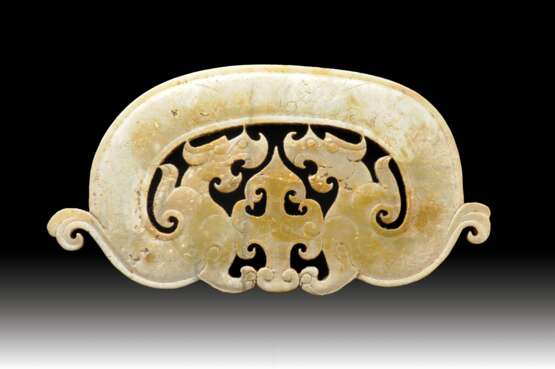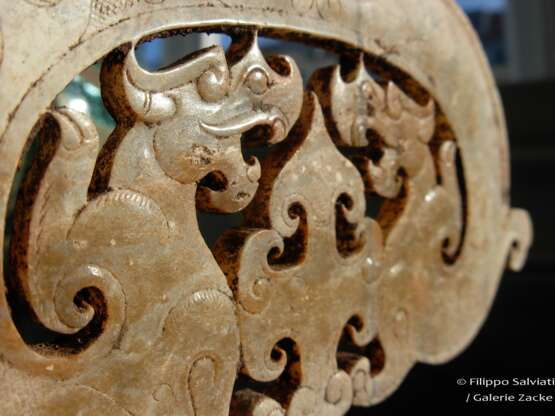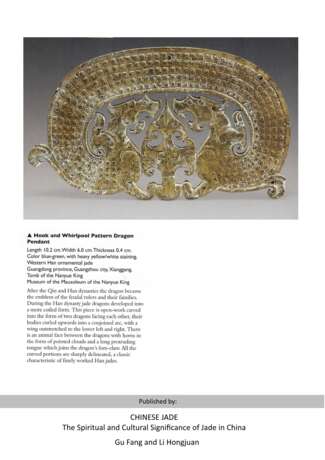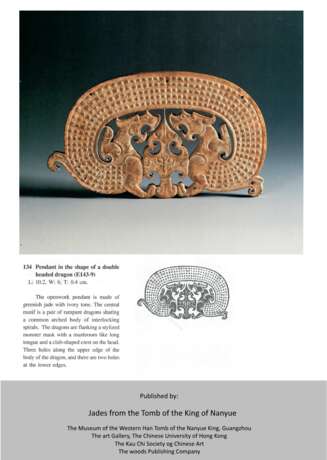ZWEIKÖPFIGER DRACHE ALS ANHÄNGER – GEGENSTÜCK ZUM DRACHENAMULETT IM PEKTORAL DES KÖNIGSGRABES NANYUE
28.04.2017 17:00UTC +01:00
Classic
Starting price
14000EUR € 14 000
| Auctioneer | Galerie Zacke |
|---|---|
| Event location | Austria, Wien |
| Buyer Premium | 27.000% |
Archive
The auction is completed. No bids can be placed anymore.

ID 960
Lot 69 | ZWEIKÖPFIGER DRACHE ALS ANHÄNGER – GEGENSTÜCK ZUM DRACHENAMULETT IM PEKTORAL DES KÖNIGSGRABES NANYUE
Estimate value
€ 28 000
Jade
China
Späte Östliche Zhou bis Westliche Han,3. -2. Jahrhundert Vor
BREITE 12,8 CM, HÖHE 6,6 CM,STÄRKE UM 5 MM
雙首龍玉環。中國,西漢代早期,公元前2世紀。寬12.8厘米,高6.6厘米,厚約0.5厘米。維也納私人舊藏。
In der unten angeführten Publikation ist ein komplettes Schmuckgehänge aus der bekannten Grabanlage des Königs von Nanyue dargestellt. Das oberste Stück in diesem Gehänge (Pektorale E143-9) ist dem hier vorliegenden sehr ähnlich betreffend Gesamtform, Drachenköpfe und das dekorative Element zwischen diesen. Die Gestaltung auf den Flächen des gewundenen Körpers ist jedoch anders und an Größe ist das königliche Vergleichsbeispiel etwas kleiner (L 10,2 cm). Was diese Jade hier nicht hat ist eine Öse. Es ist deshalb anzunehmen, dass dieses Zierstück für die Brust einfach aufgelegt war. Die Drachenköpfe sind sehr grimmig gestaltet, Nase, Kinn, Ohren etc. haben äußerst spitze und feinste, teils eingebogen auslaufende Enden - die Präzisheit ist höchst erstaunlich. Die beiden Drachen haben einen gemeinsamen Körper, der ein Oval bildet, zwei seitliche Ansätze mit Voluten, ansonsten ist die Außenkante glatt und im Verlauf ebenmäßig. Die Oberfläche des Drachenkörper-Ovals ist an diesem Stück beidseitig mit einer sehr fein gezeichneten Komposition aus geschwungenen Linien mit Voluten-Enden verziert, teils sind die Zwischenflächen mit einem dichten Gittermuster versehen.
Das dekorative Element zwischen den Drachen ist in dem angeführten Vergleichsbeispiel deutlich eine Maske, es wird als “stilisierte Maske eines Monsters” beschrieben. Hier aber ist es mehr rein dekorativ, wenn auch die Form völlig gleich ist. Das vorliegende Stück, das aus einem Prinzengrab stammen dürfte, erscheint uns insgesamt feiner, wirkt eine Nuance nobler und ist auch besser erhalten. Die Jadefarbe ist ein lichtes Gelbgrün, aufgrund der Alterung großteils weißlich geworden. Die alte Politur, einst sehr fein finalisiert, hat sich dabei bestens erhalten. Transluzenz ist durchgehend gegeben. Diese Jade ist jedenfalls ein außerordentliches Sammlerstück von besonderer Seltenheit.
Ein sehr ähnliches Vergleichsbeispiel ist publiziert in “Jades fromtheTomb of the King of Nanyue”, Universität Hongkong, Nr. 134. Oder in “Chinese Jade - The Spiritual and Cultural Significance of Jade in China” und weiteren Publikationen, wie der von Salmony ...
Diese Jade wird in dem Buch von FILIPPO SALVIATI: “THE MYSTERIOUS STONE: Chinese Jades from the Neolithic to the Han in private collections” publiziert (Erscheinungstermin Frühjahr 2017). Notes by Prof. Salviati: This delicate openwork pendant is carved in the shape of two rampant, confronted feline-looking dragons that share the same arched body: the heads and front limbs of the animals are framed by the body which is engraved with finely incised volutes filled with an etched checker board motif. The dragons are separated by an apparently abstract pattern which, in reality, is a highly stylized taotie-type mask with a bulging nose, incised scrolls standing for the eyes, side ears or horns, an open, split jaw and a crown-like protuberance on top. Two symmetrical curls extend from the sides of the pendant: they recall the similar stylized wing-like appendage carved on the back of the tiger-shaped plaque. The jade is semi-translucent and pale yellow in colour with white altered areas, minor traces of natural surface corrosion in the heads of the dragons and soil encrustations that are mostly concentrated along the sides of the cut-outs. Once again, the closest comparable example to this finely crafted pendant is offered by a similarly shaped jade discovered in the 2nd century BC tomb of King Zhao Mo of Nanyue, in Guangzhou. The comparable carving is the top element of a pectoral, formed by nine jades and beads strung together, that was placed in the burial of Zhao Mo’s wife, known as the “Lady of the Right”. The overall scheme is similar but the excavated jade differs from the present one only in some details of the decoration: the arched body of the dragon is filled with a dense pattern of raised scrolls, the taotie-like masks between the dragons have more clearly delineated eyes and the curls on the sides are carved at different points, not on the same level as the carving shown here. The jade ornament from the Nanyue tomb is reproduced in Yang Xiaoneng (ed.), The Golden Age of Chinese Archaeology. Celebrated Discoveries from The People`s Republic of China, New Haven and London, Yale University Press, 1999, no.145. Prior to the discovery of the Nanyue tomb, we knew of only one other similar pendant, shaped as two confronting dragons but without the stylized taotie mask placed between them. The pendant is part of an assemblage of jades strung together with a gold chain which was acquired in 1930 by the Freer Gallery and reputedly excavated at Jincun, near Luoyang, in Henan province (Freer/Sackler Galleries, acc. no.F1930.27a-k): http://www.asia.si.edu/collections/edan/object.php?q=fsg_F1930.27a-k.
Expertise: Wolfmar Zacken & Filippo Salviati
Aus einer Wiener Sammlung
| Address of auction |
Galerie Zacke Mariahilferstrasse 112 1070 Wien Austria | ||||||||||||||
|---|---|---|---|---|---|---|---|---|---|---|---|---|---|---|---|
| Preview |
| ||||||||||||||
| Phone | +00 4315-320 452 | ||||||||||||||
| Fax | +43-1-5320452-20 | ||||||||||||||
| Buyer Premium | 27.000 | ||||||||||||||
| Conditions of purchase | Conditions of purchase | ||||||||||||||
| Business hours | Business hours
|








